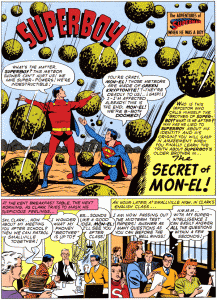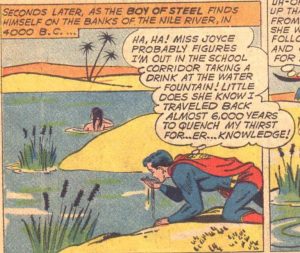Disclaimer: Some of these reviews may sound give the impression that I don’t actually enjoy these stories, because I point out their flaws. Nothing could be farther from the truth. I collected them, am re-reading them, and I review them because these stories and their creators have meant so much to me throughout my life. I can point out mistakes and plot points that I, as an author, would hopefully not have made. But I, as an author, have not brought to readers a fragment of the joy that these creators have. Their sheer imaginative power is nothing short of wondrous.
 Robert Berstein had not written any Legion stories to date. He was the regular Superboy writer for three years, however, and co-creator, with George Papp, of Mon-El. Unlike Edmond Hamilton and Otto Binder, he did not have a science fiction pedigree, nor was he, like Jerry Siegel, a godfather of all super-hero comics. He was actually a playwright and composer, who had largely written crime and war comics before being assigned to the Superman line in 1959. He had created the Phantom Zone only two months before Mon-El’s first appearance.
Robert Berstein had not written any Legion stories to date. He was the regular Superboy writer for three years, however, and co-creator, with George Papp, of Mon-El. Unlike Edmond Hamilton and Otto Binder, he did not have a science fiction pedigree, nor was he, like Jerry Siegel, a godfather of all super-hero comics. He was actually a playwright and composer, who had largely written crime and war comics before being assigned to the Superman line in 1959. He had created the Phantom Zone only two months before Mon-El’s first appearance.
The second half of Mon-El’s origin is a wonderful trip through the world of DC Silver Age comics, and the time period itself, to a certain extent. We open with Clark Kent sitting in his high school classroom. That Clark is in a sweater vest and tie is hardly surprising. That all the other boys are actually wearing suits looks pretty funny to a modern reader. What happens in the classroom has absolutely zero to do with the Mon-El story, but is worth noting simply for its humor, and as another example that Clark’s Kryptonian hormones must have been raging at this point in his life, ’cause the boy just ain’t acting normal.
The class is taking a test, and Clark, a super-genius of course, will score 100 on it if he’s not careful. “Careful” means getting a 90. But the thrill of intentionally getting a question wrong is not enough for him, clearly. When confronted with the question, “Was there a historical Cinderella?” Clark, who knows the answer is “No one can know the origins of a fairy tale,” decides to ask his teacher if he can get a drink of water. He then proceeds to fly back in time to ancient Egypt and find Rhodopis, the maiden whose story was the earliest known instance of a “Cinderella story.”
He finds her bathing in the Nile, naked. Naturally he stops to take a drink out of the naked water—I mean the Nile water. His comment as he does so is priceless.
Admirable restraint on not actually quenching the thirst in question, Clark!
After seeing how Rhodopis’s slipper was stolen by a passing eagle, and how, six months later, the Pharoah tracked her down, because he had a serious foot fetish, obviously, and made her his wife, Clark returns to his classroom and records the whole story on his test paper. It turns out to be the only question that’s marked wrong, and earns him an 89 on the rest.
Dude, isn’t an 89 a Kryptonian ‘F?’
The idea of a teacher marking a correct answer wrong based on her own ignorance is quite realistic, and probably delighted young readers of the time. But, seriously, a question in which the expected answer was “Nobody knows the origins of fairy tales” was worth 11 percent?! Nuh-uh.
There was a Rhodopis legend, and it is the earliest known story of Cinderella. She was Greek, however, so it’s a bit odd that she would be bathing in the Nile.
Back in the world of Mon-El, Clark is still silently dismissing his “brother” as a “phoney,” [sic. again] but he lets the impostor accompany him on a mission when Smallville’s Chief Parker calls on the special Superboy radio frequency to say that the local bank is being bombarded with giant lead balls.
The special Superboy radio frequency. Huh. The Kents observe that it must be “The White House, Professor Lang or Chief Parker.” Ya know, if I had a hotline for use by the President and my local police chief, I’m not sure I’d give the number to my girlfriend’s father. The Governor and the Attorney General might be pissed, after all. And speaking of girlfriends, Lana seems to have received a promotion since her last adventure in Legion lore. Clark openly refers to her as such, and is even more openly jealous when Mon-El pays attention to her. This is the straw, it seems, which causes him to lay a plan to do something once and for all about his fake brother.
The boys fly to an asteroid to mess around. Before they leave, in secret, Clark paints some giant lead balls green, so they look like Kryptonite, and launches them into space so that they’ll rain down on the asteroid after he and Mon-El arrive. (Smallville seems to have a preponderance of Giant Lead Balls. Not something you just find in your local Wal-Mart, generally, but this is the Mid-West. Things are different. Bigger and Ballsier.)
While playing baseball with giant rocks, the boys find a giant, monster jack-in-the-box, which they speculate is a toy dropped by an alien ship. Their first thought? “Let’s destroy it!” They proclaim this with glee, and then have a few panels’ worth of boyish fun destroying this thing. “We found some kid’s toy. Let’s smash it!” Little vandals!
Seriously, these were the days when the cover was drawn first, so Bernstein probably had to come up with some way to explain what the hell the thing was doing in the story.
After the juvenile delinquents—I mean stalwart heroes—have had their fun, the artificial “meteor shower” begins. Superboy fakes Kryptonite poisoning to see if Mon-El will too. At which point he will call him out on his ruse, which he does… Only to find out that he has actually fatally poisoned this poor, innocent kid who never did anything except play along with the “brother” fantasy. Well, and destroy private property, but let’s not quibble.
Dying, Mon-El finds his memory shocked back. He’s Lar Gand from Daxam, and he’s allergic to lead. Moving him away will not save him. He’s going to die. But first, he stops to tell his killer the truth about his past. He visited Krypton shortly before its destruction. Jor-El and Lara took him in and repaired his ship. When he left, just in time to avoid the final explosion of the planet, Jor-El gave him a star chart so he could go to Earth.
Why Earth? Why not home to Daxam? It’s never discussed. Maybe to watch over baby Kal-El. Lara also gave Mon-El a necklace because, she says, they have “learned to love” him.
Is it just me, or should Jor-El have been perhaps a bit concerned about his 20-something wife learning to love the 18+ year-old boy that was living in his house.
Maybe the story should have been called “Superboy’s Next Teen Stepdad?” Or maybe I have a jaded, 21st Century mind. Or maybe both.
Famously, to save his victim’s—friend’s!—to save his friend’s life, Superboy sends Mon-El into the phantom zone, introduced in April 1961’s. Adventure Comics #283. Superboy promises to find a cure for the lead poisoning and rescue Mon-El someday, and the closing caption promises that Superman will soon return to the Phantom Zone.
But it begs the question, if the phantom zone was this great storage freezer, this great legendary thing, why didn’t Superboy send everyone who was dying there? Why didn’t he send Ma and Pa kent there a few years later? Or does the zone only allow non-humans to survive there? Or did Pa Kent just hold up his hand and shake his head and–
God, why can’t I un-see that?


Spoiler Alert: The Ma and Pa Kent dying/Phantom Zone situation was addressed in 1963.
Thanks! I don’t think I’ve read that one. I’ll track it down.